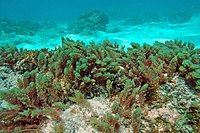
Photo from wikipedia
Simple Summary There is increasing interest in the red seaweed Asparagopsis taxiformis due to its potential use as a feed supplement to knock out methane emissions of ruminants. Yet, there… Click to show full abstract
Simple Summary There is increasing interest in the red seaweed Asparagopsis taxiformis due to its potential use as a feed supplement to knock out methane emissions of ruminants. Yet, there is little understanding of its molecular biology, including the proteins that facilitate photosynthesis, metabolite biosynthesis, growth and reproduction. This study used different extraction procedures to elucidate proteins from A. taxiformis (Lineage 6) sporophytes (diploid stage) and gametophytes (haploid stage). The outcome is the most comprehensive overview of expressed proteins in a seaweed, with interesting insights into the potential functions of proteins. This provides a foundation for future targeted protein extraction from A. taxiformis in search of potential bioactive molecules relevant to health and ecology. Abstract The red seaweed Asparagopsis taxiformis is a promising ruminant feed additive with anti-methanogenic properties that could contribute to global climate change solutions. Genomics has provided a strong foundation for in-depth molecular investigations, including proteomics. Here, we investigated the proteome of A. taxiformis (Lineage 6) in both sporophyte and gametophyte stages, using soluble and insoluble extraction methods. We identified 741 unique non-redundant proteins using a genome-derived database and 2007 using a transcriptome-derived database, which included numerous proteins predicted to be of fungal origin. We further investigated the genome-derived proteins to focus on seaweed-specific proteins. Ontology analysis indicated a relatively large proportion of ion-binding proteins (i.e., iron, zinc, manganese, potassium and copper), which may play a role in seaweed heavy metal tolerance. In addition, we identified 58 stress-related proteins (e.g., heat shock and vanadium-dependent haloperoxidases) and 44 photosynthesis-related proteins (e.g., phycobilisomes, photosystem I, photosystem II and ATPase), which were in general more abundantly identified from female gametophytes. Forty proteins were predicted to be secreted, including ten rhodophyte collagen-alpha-like proteins (RCAPs), which displayed overall high gene expression levels. These findings provide a comprehensive overview of expressed proteins in A. taxiformis, highlighting the potential for targeted protein extraction and functional characterisation for future biodiscovery.
Journal Title: Biology
Year Published: 2023
Link to full text (if available)
Share on Social Media: Sign Up to like & get
recommendations!